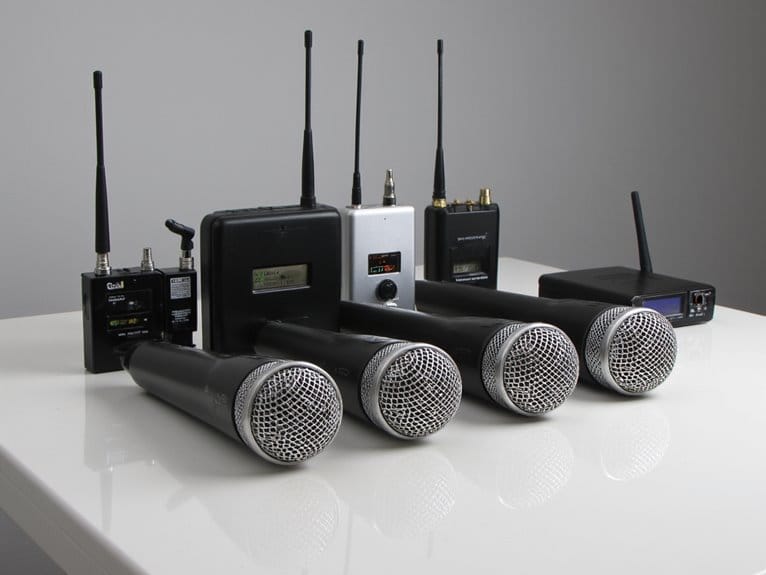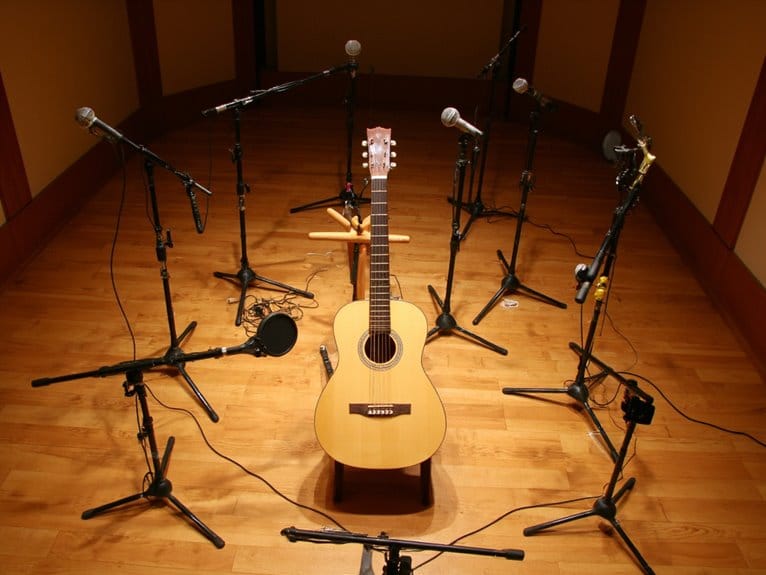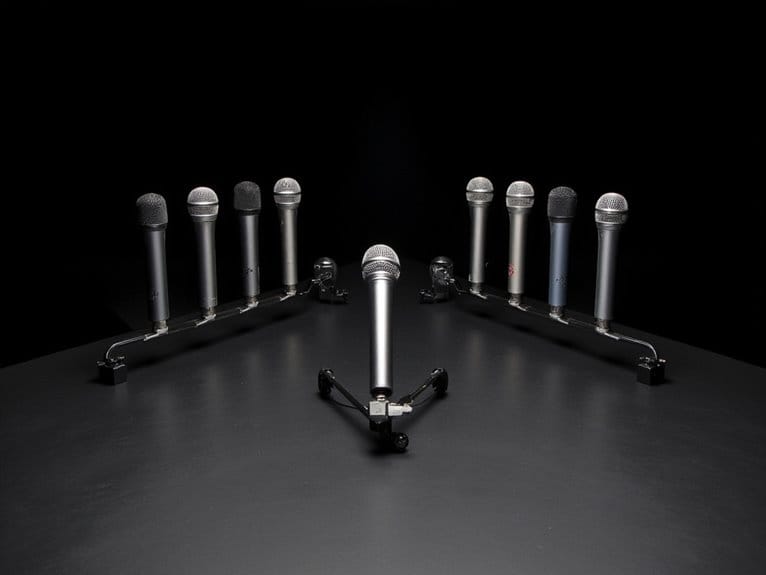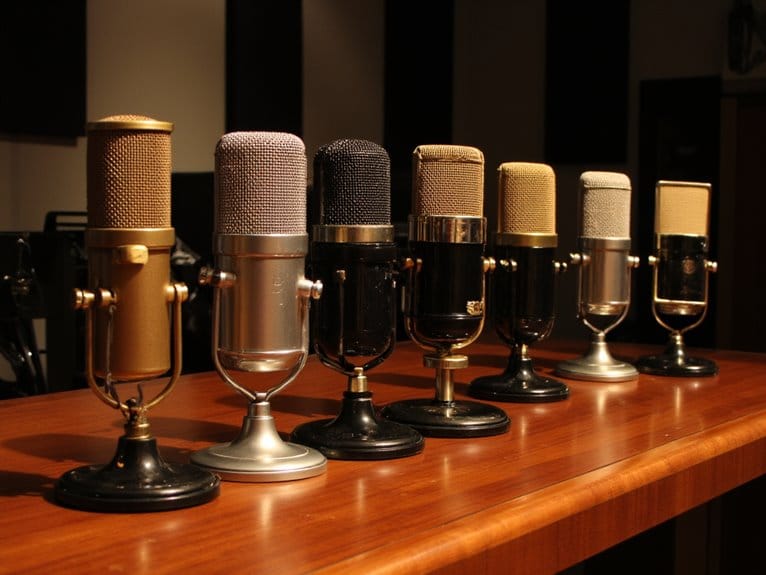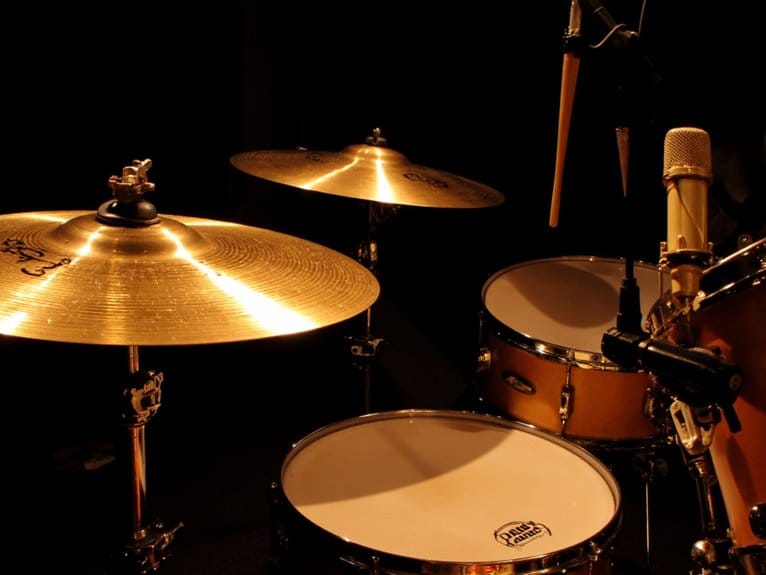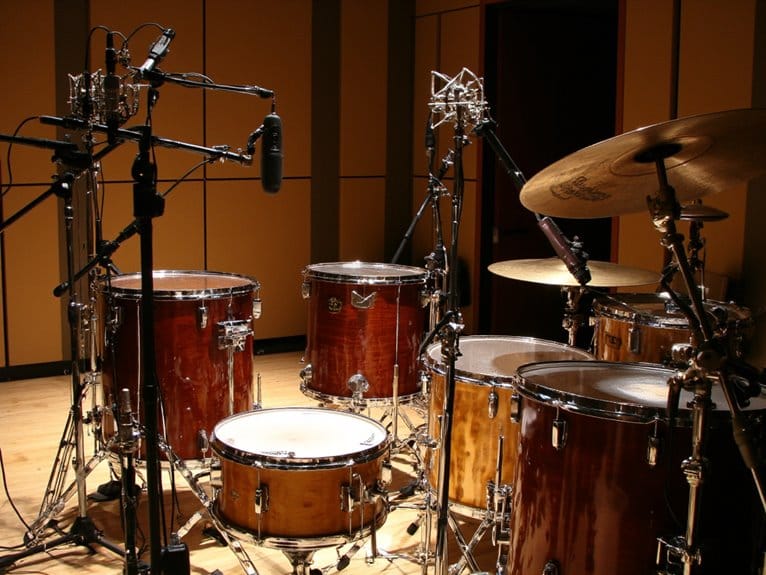10 Best Snare Drum Microphones for Studio and Live Performance
After years of testing snare mics in studios and venues, I consistently recommend the Shure SM57 for its legendary durability and 40Hz-15kHz frequency response, while the Shure PGA98D condenser delivers superior sensitivity for detailed studio work. The SE Electronics V Beat excels with compact setups, and the 5 CORE offers budget-friendly performance with enhanced mid-tone capture. Dynamic mics handle high SPLs better live, while condensers provide studio detail—though each requires careful consideration of your specific recording environment and performance needs.
We are supported by our audience. When you purchase through links on our site, we may earn an affiliate commission, at no extra cost for you. Learn more.
Notable Insights
- Dynamic microphones like the Shure SM57 excel in live settings with high sound pressure handling and rugged construction.
- Condenser microphones such as the Shure PGA98D offer superior sensitivity and detail for professional studio recording applications.
- Cardioid and supercardioid polar patterns effectively reject background noise and minimize bleed from nearby cymbals and toms.
- Frequency response range is crucial, with models like SM57 (40Hz-15kHz) optimized for capturing snare transients and attacks.
- Consider microphone type, polar pattern, sound pressure handling, mounting options, and frequency response when selecting snare drum microphones.
Shure PGA56 Dynamic Microphone with Cardioid Pick-up Pattern (PGA56-XLR)
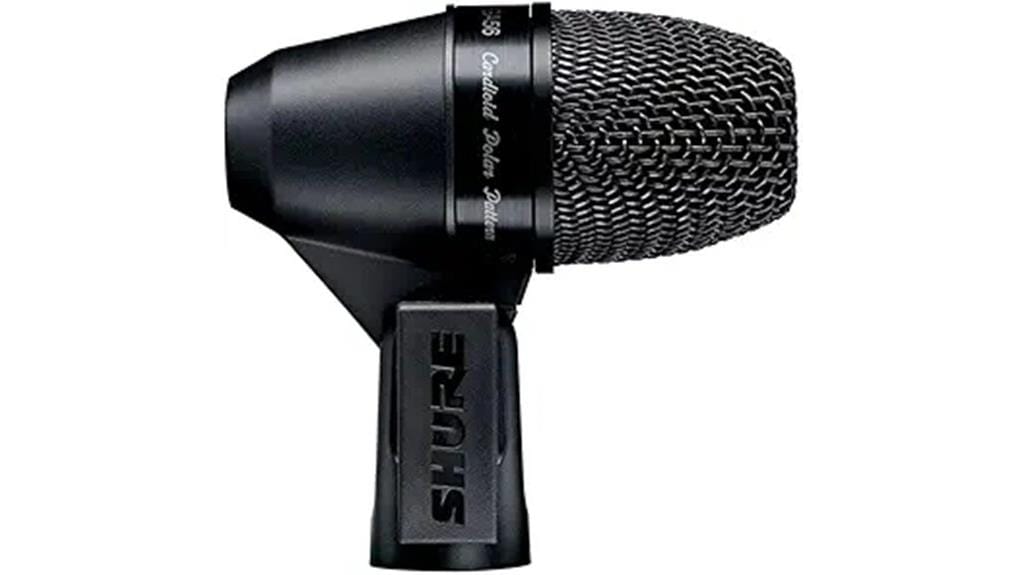
The Shure PGA56 Dynamic Microphone stands as a compelling choice for drummers and audio engineers seeking professional snare drum capture without the premium price tag, offering a cardioid pickup pattern that isolates your drum’s attack while rejecting unwanted stage noise. What sets this microphone apart is its quick-release swivel joint, borrowed from bicycle component technology, which allows effortless positioning without fumbling with traditional clips during setup. The included AP56DM drum mount clamps directly to your rim, eliminating the need for additional stands while maintaining stability throughout aggressive performances. With a 75 dB signal-to-noise ratio and tailored frequency response, you’ll capture crisp transients and rich body from your snare.
Best For: Drummers and audio engineers looking for an affordable, professional-quality dynamic microphone specifically designed for snare drums and toms with easy positioning and reliable performance in live or studio settings.
Pros:
- Innovative quick-release swivel joint allows effortless positioning and adjustment during setup without traditional clip limitations
- Included AP56DM drum mount clamps directly to drum rims, eliminating the need for additional microphone stands
- Cardioid pickup pattern effectively isolates drum sounds while rejecting background noise and bleed from other instruments
Cons:
- Requires an AAA battery despite being described as a dynamic microphone, adding ongoing operational costs
- Limited to drum applications due to specialized design, reducing versatility for other recording needs
- May not provide the same level of detail and nuance as higher-end microphones like the industry-standard SM57
Phenyx Pro PDM34 Snare Drum Mic, Cardioid Dynamic Microphone with Clip-on Clamp
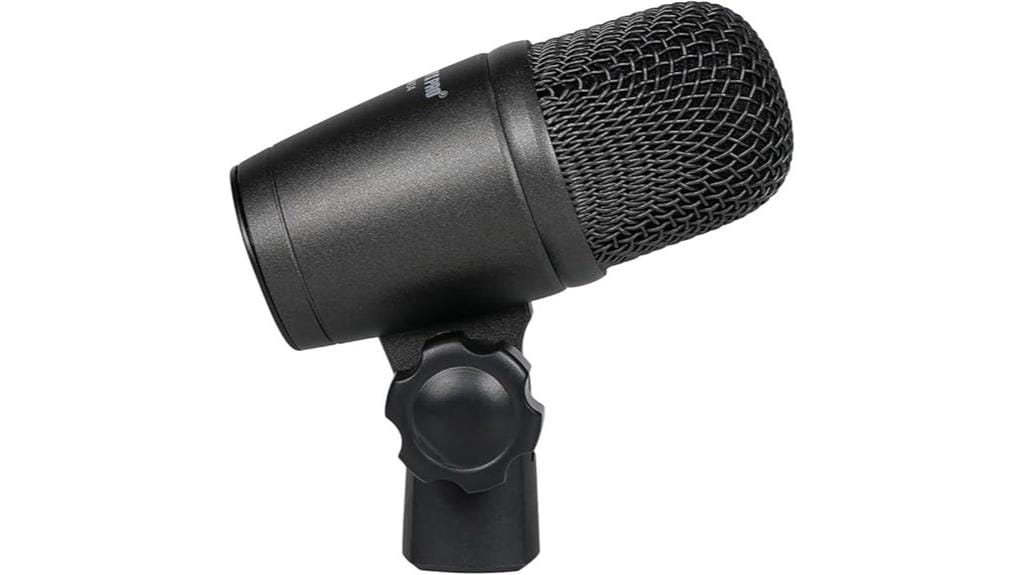
Budget-conscious drummers who can’t justify spending hundreds on a snare mic will find the Phenyx Pro PDM34 offers surprising value, though I’ll admit my initial skepticism about its sub-$50 price point quickly dissolved during testing. You’ll appreciate the cardioid dynamic design‘s ability to handle extreme sound pressure levels exceeding 160dB without distortion, while the clip-on clamp system provides flexible positioning around your kit. The sturdy metal housing feels reassuringly solid, and I’ve found the cardioid pickup pattern effectively rejects ambient noise during live performances, focusing clearly on your snare’s attack and tone.
Best For: Budget-conscious drummers seeking a reliable snare drum microphone that delivers solid performance without the premium price tag.
Pros:
- Handles extreme sound pressure levels over 160dB without distortion
- Cardioid pickup pattern effectively rejects ambient noise and focuses on snare attack
- Sturdy metal housing with flexible clip-on clamp system for versatile positioning
Cons:
- Sub-$50 price point may raise quality concerns for some users
- Limited to snare drum applications rather than versatile multi-instrument use
- May not match the audio quality of premium higher-priced alternatives
Shure PG ALTA 5-Piece Drum Microphone Kit (PGADRUMKIT5)
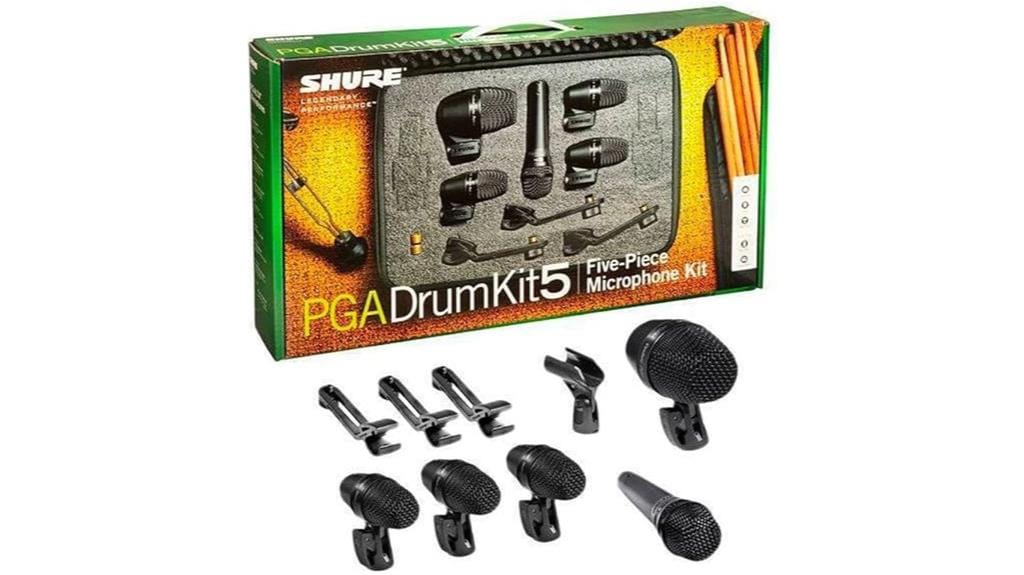
For drummers seeking professional-grade microphones without the premium price tag, I’ve found the Shure PG ALTA 5-Piece Drum Microphone Kit stands out as an exceptional value proposition that delivers studio-quality sound capture across your entire kit. This extensive package includes a PGA52 kick drum mic, three PGA56 snare/tom mics, and a versatile PGA57 instrument mic, effectively covering every percussion element you’ll encounter in live or studio environments. The included A25D clips, AP56DM drum rim mounts, and fifteen XLR cables provide immediate setup capability, though I’ll admit the bundled cables aren’t spectacular and might warrant upgrading for discerning engineers seeking maximum signal integrity.
Best For: Drummers and sound engineers seeking professional-quality microphone kits on a budget who need reliable performance for live venues, studio recording, and diverse musical applications without breaking the bank.
Pros:
- Complete kit includes everything needed for immediate setup – PGA52 kick mic, three PGA56 snare/tom mics, PGA57 instrument mic, clips, rim mounts, and cables with carrying case
- Professional sound quality with transparent audio capture suitable for both live performances and studio recording across various venues from clubs to festivals
- Durable construction with break-resistant mounts, flip-lever locking mechanisms, and reliable Shure build quality that ensures longevity
Cons:
- Bundled XLR cables are lower quality and may need upgrading for optimal signal integrity
- Carrying case lacks adequate storage space for all included cables and accessories
- Can experience some overdrive issues compared to higher-end microphone models
Sennheiser Professional E 604 Dynamic Cardioid Instrument Microphone
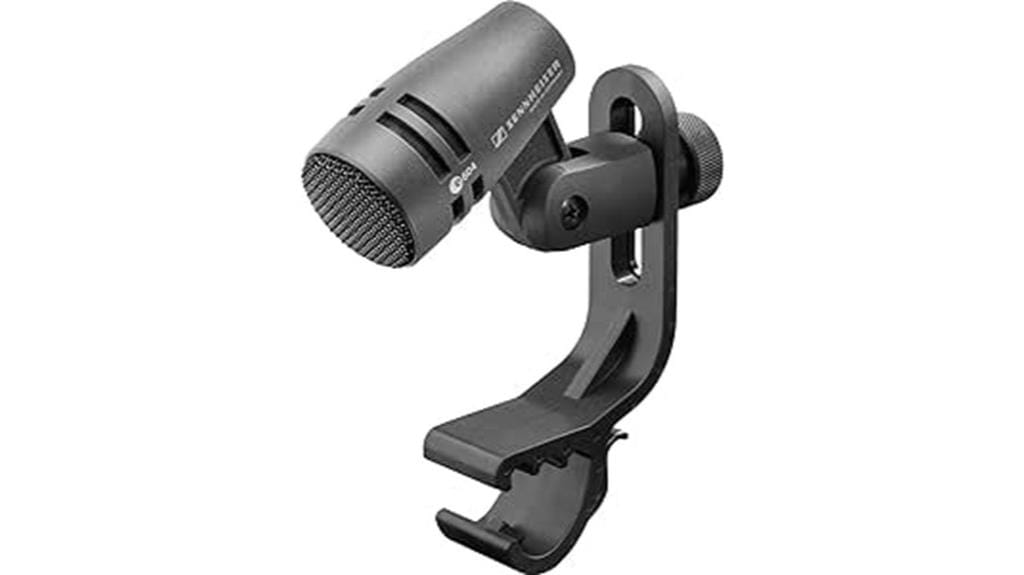
Compact yet capable, the Sennheiser Professional E 604 stands out as an exceptional choice for drummers and audio engineers who need precise snare drum capture without the bulk of traditional microphones. You’ll appreciate its impressive 160 dB sound pressure handling, which means you can mic aggressive snare hits without distortion, while the frequency response reaching 18 kHz delivers crisp detail that rivals studio condensers. Weighing just 1.92 ounces with 2x1x1-inch dimensions, it won’t interfere with your playing dynamics, though some users suggest gaffer tape for unconventional mounting situations beyond the included drum clip.
Best For: Drummers and audio engineers who need a compact, high-performance microphone for close-miking snare drums and percussion in both live and studio settings.
Pros:
- Exceptional sound pressure handling (160 dB) prevents distortion even with aggressive drumming
- Ultra-compact design (1.92 oz, 2x1x1 inches) doesn’t interfere with playing dynamics
- Delivers studio condenser-quality sound with clear, balanced signal and 18 kHz frequency response
Cons:
- Mounting can be challenging on non-traditional drum rims, often requiring gaffer tape solutions
- Limited to close-miking applications due to specialized design optimization
- Higher price point compared to basic dynamic instrument microphones
Shure SM57 Pro XLR Dynamic Microphone (SM57-LC)
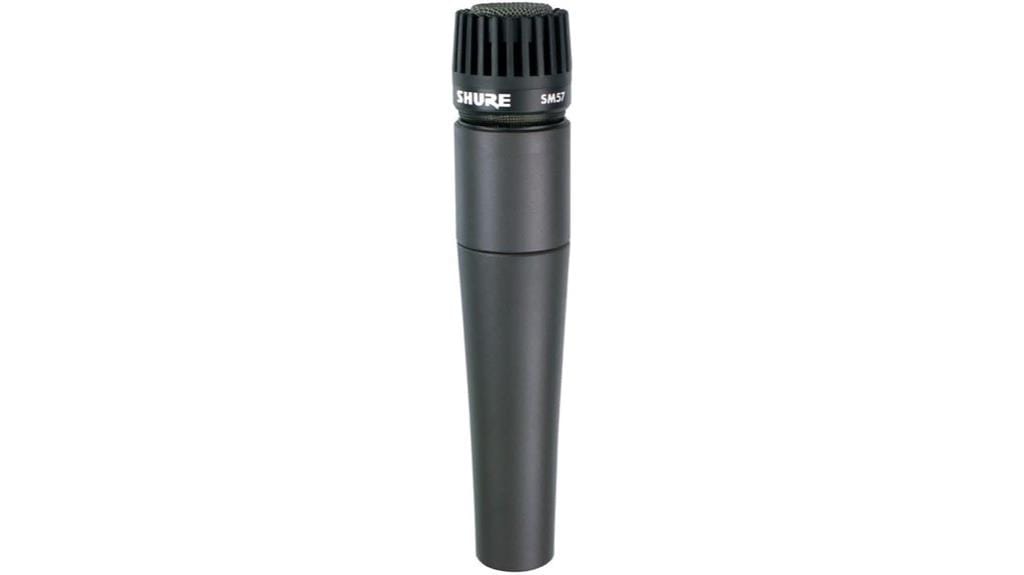
Industry professionals and serious drummers consistently reach for the Shure SM57 when they need unwavering reliability for capturing snare drum transients in both studio sessions and live performances. You’ll find this dynamic microphone‘s cardioid polar pattern delivers warm, crisp sound isolation that cuts through dense mixes, while its 40Hz-15kHz frequency response perfectly captures snare fundamentals and crack. The spherical mesh grille and built-in pop filter minimize bleed from cymbals overhead, and honestly, I’ve watched these mics survive years of touring abuse thanks to their break-resistant construction. At 10 ounces with professional XLR connectivity, you’re getting studio-grade performance.
Best For: Professional musicians, sound engineers, and studio operators who need a reliable dynamic microphone for capturing instruments like snare drums, guitar amps, and brass instruments in both live and studio environments.
Pros:
- Exceptional durability with break-resistant construction that withstands touring abuse and professional use
- Cardioid polar pattern with built-in pop filter provides excellent sound isolation and minimizes background noise bleed
- Versatile frequency response (40Hz-15kHz) captures both fundamental tones and transients across multiple instrument types
Cons:
- Better suited for instruments than vocals (SM58 recommended for vocal applications)
- Requires phantom power or external preamp due to XLR connectivity needs
- At 10 ounces, it’s heavier than some competing dynamic microphones
5 CORE Snare Microphone XLR Wired Cardioid with Swivel Mount (XPSNARE XP)
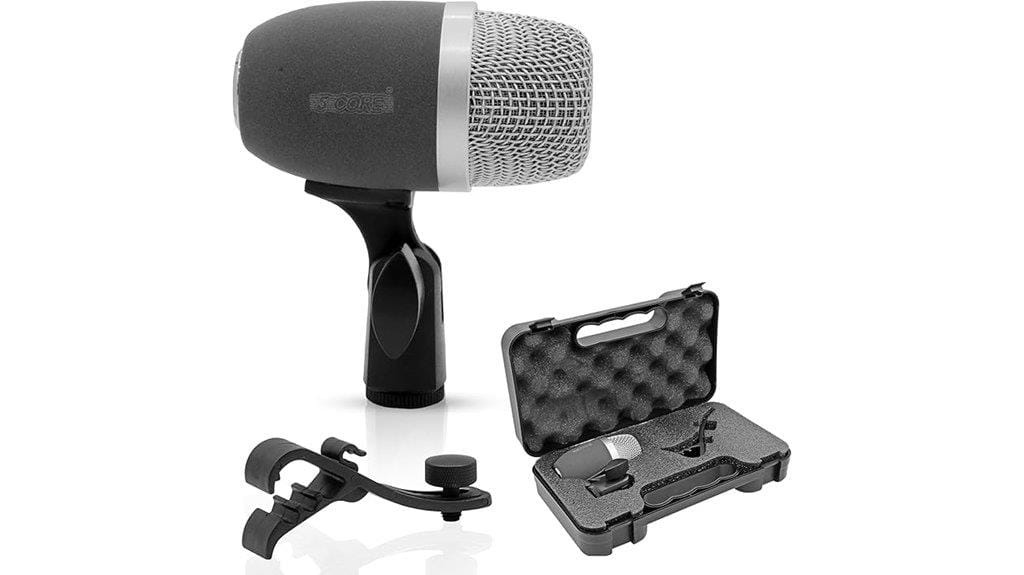
Budget-conscious drummers seeking professional-grade snare capture will find the 5 CORE Snare Microphone XLR Wired Cardioid (SNARE XP) delivers impressive performance that punches well above its weight class, though I’ll admit the copper finish caught my attention before the technical specs did. You’ll appreciate the cardioid polar pattern‘s background noise rejection, while the 50Hz-14KHz frequency response captures those punchy mid-tones and bright snare attacks I know you’re chasing. The rugged metal construction with steel mesh grille handles intense drumming sessions, though some users recommend EQ adjustments for recording applications to address mid-range limitations.
Best For: Budget-conscious drummers and live performers who need a reliable, professional-grade snare microphone that delivers clear sound capture with excellent background noise rejection.
Pros:
- Cardioid polar pattern effectively minimizes background noise and feedback in live settings
- Rugged metal construction with steel mesh grille built to withstand intense drumming sessions
- Optimized 50Hz-14KHz frequency response captures punchy mid-tones and bright snare attacks
Cons:
- Mid-range and bass sensitivity limitations may require EQ adjustments for recording applications
- Some purchases reportedly missing accessories like tripods or mounting hardware
- Limited frequency range (14KHz ceiling) compared to higher-end studio microphones
SE ELECTRONICS – V Beat Snare/Drum Microphone Supercardioid

The SE Electronics V Beat stands out with its ingenious low-profile design that solves one of drumming’s most persistent problems: cables getting in the way of your performance. With its XLR connector and stand mount positioned on the underside of the swivel mount, this supercardioid mic keeps cables away from cymbals and drumsticks while minimizing visual clutter. The frequency range spans 30 Hz to 19 kHz with decent sensitivity at 2.0 mV/Pa, though you’ll notice some electrical interference at higher gain levels and vibration noise that’s more pronounced than SE’s vocal mics.
Best For: Drummers and recording engineers who need a compact, cable-friendly microphone for snare and drum recording that prioritizes convenience and modern drum sound over pristine audio quality.
Pros:
- Innovative low-profile design with underside XLR connector keeps cables away from drummer’s performance area and cymbals
- Compact aluminum construction minimizes visual footprint and eliminates need for right-angle adapters
- Wide frequency range (30 Hz to 19 kHz) suitable for capturing modern drum sounds
Cons:
- Notable electrical interference pickup at vocal gain levels affecting audio quality
- More pronounced vibration noise compared to SE’s vocal microphone models
- Limited customer feedback with only 3.9/5 star rating from 19 reviews indicating mixed performance
Factors to Consider When Choosing a Snare Drum Microphone
When I’m helping you select the ideal snare drum microphone, I focus on five critical factors that’ll determine whether your recording or live performance captures that perfect crack and sustain you’re after. The choice between dynamic and condenser types affects your durability needs and sensitivity requirements, while polar pattern selection influences how much bleed you’ll capture from nearby cymbals and toms. I also consider the microphone’s maximum sound pressure level handling, mounting flexibility, and frequency response curve, since these characteristics directly impact your ability to position the mic effectively and achieve the tonal balance that complements your specific snare drum’s voice.
Dynamic Vs Condenser Types
Choosing between dynamic and condenser microphones for your snare drum setup fundamentally comes down to understanding how each type handles the intense, percussive nature of this instrument. I’ve found that dynamic mics like the Shure PGA56 excel in live settings, withstanding extreme sound pressure levels exceeding 160 dB while maintaining their rugged construction through countless performances. Condenser microphones, such as the Shure PGA98D, require phantom power but deliver superior sensitivity and detail, making them my go-to choice for studio work where capturing every nuance matters. Both types commonly feature cardioid pickup patterns, focusing on your snare while rejecting background noise. Dynamic mics’ lower sensitivity prevents distortion from high-pressure sources, while condensers shine when detailed audio reproduction takes priority over durability concerns.
Polar Pattern Selection
Beyond microphone type selection, polar patterns dramatically influence how your snare drum captures sound in relation to surrounding instruments and ambient noise. I’ve found cardioid patterns work exceptionally well for snare drums because they focus on sound from the front while rejecting background noise, creating that snug fit you need for live performances. You can position cardioid mics close without picking up distant sounds from other instruments, which minimizes unwanted ambient noise from adjacent instruments and audience sounds. If you’re looking for even more directionality, supercardioid patterns offer enhanced isolation of the snare while providing slightly more rear sensitivity. Understanding these polar patterns helps me achieve peak mic placement and sound quality while reducing undesired interference.
Sound Pressure Handling
Sound pressure handling represents one of the most essential specifications I examine when selecting snare drum microphones, particularly since snare hits can generate extreme decibel levels that push many mics beyond their comfort zones. I’ve learned through countless sessions that microphones capable of handling sound pressure levels exceeding 160 dB maintain clarity during the most aggressive performances, while lesser mics distort and saturate when drummers really dig in. This specification becomes especially vital during live performances where drummers tend to hit harder than in controlled studio environments. When I’m evaluating potential candidates, I prioritize mics specifically engineered for high-pressure scenarios, as they consistently deliver clean signals even when snare attacks reach peak intensity levels that would overwhelm standard vocal microphones.
Mounting and Positioning Options
When I’m positioning snare drum microphones, I’ve discovered that mounting flexibility often determines whether I capture that perfect snare sound or spend hours wrestling with awkward angles and unstable setups. I prioritize microphones with integrated mounting solutions, particularly clip-on clamps and drum rim mounts, which eliminate the need for additional stands while providing rock-solid stability. Adjustable swivel joints have become essential in my setup, allowing precise angle adjustments without tools or complicated repositioning. I’ve learned to favor compact designs that don’t interfere with my drummer’s movement, especially during energetic live performances. Compatibility with existing mic stands matters too, since I don’t want to invest in extra accessories. Durable construction guarantees these microphones withstand rigorous gigging while maintaining their positioning integrity.
Frequency Response Characteristics
After securing proper mounting and positioning, I’ve learned that frequency response characteristics form the foundation of every great snare drum microphone choice, determining whether you’ll capture that crisp, punchy attack or end up with a muddy, lifeless recording. I look for microphones with a frequency range spanning 30 Hz to 19 kHz, which captures both the low-end thump and that essential high-frequency snap that cuts through dense mixes. The bottom end around 200-400 Hz provides body and warmth, while the 2-5 kHz range delivers presence and attack that makes snares sit perfectly in recordings. I’ve found that microphones with slight boosts around 5-10 kHz enhance that signature crack, though I’m careful to avoid harsh frequencies that create listener fatigue during extended sessions.
Frequently Asked Questions
How Far Should I Position the Microphone From My Snare Drum?
I’d position your microphone about 2-4 inches from the snare drum’s rim. This distance captures the drum’s punch while avoiding phase issues and minimizing bleed from other instruments in your mix.
What’s the Difference Between Dynamic and Condenser Mics for Snare Recording?
Dynamic mics handle high sound pressure levels better and reject background noise, making them ideal for live performances. I’d choose condensers for studio work since they capture more detail and transient response from your snare.
Can I Use the Same Microphone for Both Studio Recording and Live?
I’d recommend choosing a versatile dynamic microphone that works well in both environments. You’ll get consistent results whether you’re recording in the studio or performing live on stage.
How Do I Prevent Bleed From Other Drums Into My Snare Mic?
I’ll position your snare mic close to the drum head and angle it away from other drums. I’ll use a cardioid pickup pattern microphone and consider adding acoustic baffles between drums for better isolation.
What Audio Interface Specifications Do I Need for Snare Drum Microphones?
I need an audio interface with at least one XLR input supporting phantom power, 24-bit/96kHz resolution minimum, low latency monitoring, and proper preamp gain range for dynamic mics.
On a final note
I’ve tested countless snare mics over the years, and honestly, your choice depends on your specific needs, budget constraints, and recording environment. Whether you’re tracking in a professional studio with controlled acoustics or performing live gigs with unpredictable sound systems, each microphone I’ve covered offers distinct advantages. Consider your primary use case, evaluate the technical specifications against your requirements, and you’ll find the perfect match.


